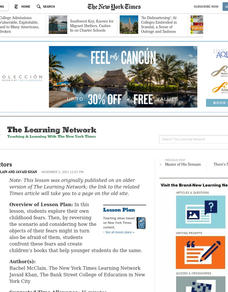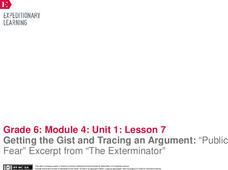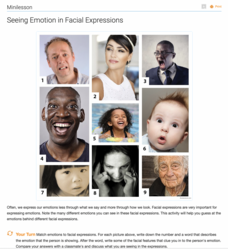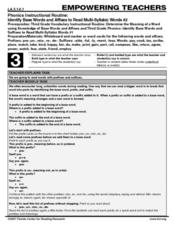Curated OER
What is Theme?
What is theme, and how can you find themes in literary works? These and other questions are answered by a colorful and engaging presentation that not only defines the term but also provides easy to understand examples. The slides...
Curated OER
Fear Factors
Students explore their own childhood fears. Then, by reversing the scenario and considering how the objects of their fears might in turn also be afraid of them, students confront these fears and create a student books that help younger...
EngageNY
Getting the Gist and Tracing an Argument: “Public Fear” Excerpt from “The Exterminator”
Only fear fear itself. Scholars read Public Fear from The Exterminator. Triads work together to annotate and determine the gist of the text. They then complete a Tracing an Argument graphic organizer to identify arguments, claims, and...
Nebraska Department of Education
Zeteophobia
You know hydrophobia, arachnophobia, and maybe even ophidiophobia, but do you recall Zeteophobia, the least famous phobia of all? As part of a Career Development series, job seekers investigate the power of zeteophobia, the fear that...
Education Foundation of Sarasota County
Self-Calming Strategies to Manage Emotions
Tweens and teens learn coping skills to help manage strong emotions such as anger, fear, and sadness with a lesson plan that asks them to generate a list of self-calming strategies they use and to consider the suggestions in a short...
Thoughtful Learning
Seeing Emotion in Facial Expressions
Learning to read body language, especially facial expressions, is the focus of a mini-lesson. Young learners examine a series of photographs, identify the emotion being illustrated, and then discuss the cues that revealed the emotion.
Kids' Pages
Feelings Matching 2
What does it look like when someone is feeling sad, worried, hungry, or happy? These are some of the emotions that your youngsters will identify in a simple matching activity.
Waunakee Community School District
Identifying Themes in Literature
If your language arts learners have a hard time determining the universal theme of a written work, use a straightforward learning exercise to help them find it. After reviewing a list of common themes, kids note the title, character,...
Curated OER
What Can I Do?
Here is a good way for children to identify ways to handle conflict. They discuss the connection between feelings and conflict. Everyone listens to a story about a conflict between two friends and they discuss what they could have done...
Humanities Texas
Primary Source Worksheet: Franklin D. Roosevelt, First Inaugural Address
Young historians will learn not to fear primary source materials (or fear itself, for that matter) thanks to this resource that uses Franklin D. Roosevelt's March 4, 1933 Inaugural Address to model how to conduct a close reading of such...
Curated OER
Exploring Emotions Through Activities
You'll definitely want this rich compilation of worksheets and activities in your toolbelt as you review and discuss the range of emotions we have as human beings. Activities include defining feelings, identifying ways we express...
Elementary School Counseling
When I Feel...
Help youngsters become proactive thinkers and emotional beings with these great worksheets, in which pupils identify what strategies they will use in order to address big feelings, like happiness, sadness, anger, and fear.
K12 Reader
Call of the Wild
Using a paragraph from Jack London's Call of the Wild, readers demonstrate their ability to identify the main idea and supporting ideas in a passage.
Indigo Daya
Living With Difficult Emotions Self-Help Booklet
Anger, Sadness, Shame, Fear. A self-help booklet offers insight into how to manage these emotions. Included is information about helpful and unhelpful responses to these emotions, as well as worksheets that ask responders to reflect on...
Health Smart Virginia
Inside Out Emotions
Following a viewing of Disney/Pixar's Inside Out, scholars list the five emotions depicted in the film—joy, sadness, anger, fear, and disgust. Learners complete a handout and discuss their answers. To close the lesson, peers share a...
Curated OER
Teen Living: Six Basic Emotions
Helping teens recognize and identify the six basic emotions, this activity involves a game in which they match feelings with statements on cards. No game card content is attached. View film clips first with no sound to evaluate body...
Curated OER
Phonics: Identify Base Words and Affixes to Read Multi-Syllabic Words
Encountering a new an unfamiliar word can stump even the best readers. Third graders learn how to assess the base, prefix, and suffix of words to help them determine its meaning. The class works together to go over a series of common...
Education Fund
Fear the Scarce Resources
In a life or death situation, what resources would you choose to survive—and why? A zombie attack simulation teaches learners the concepts of scarcity and resources in regards to economics. The hands-on activity requires individuals to...
Curated OER
Poetry Analysis Sheet
Tasking class members to analyze a poem can strike fear into the hearts of many learners. Here's a worksheet that takes the mystery out of the process by providing questions about what to look for in the text and to the devices poets use...
Roy Rosenzweig Center for History and New Media
Analyzing Political Campaign Commercials
Imagine a lesson that models for learners how to separate facts from opinions. How to detect bias. How to evaluate a source of information. How to identify propaganda. Although designed for middle schoolers, the activities in this packet...
Curated OER
Oil Crisis: What Would You Do?
The dynamics between the economies and politics of the United States and the Middle East are here to study. Upper graders read and discuss scenarios relating to OPEC and the current oil crisis, then in small groups role-play members of...
Advocates for Human Rights
Nativism and Myths about Immigrants
Where do anti-immigrants myths come from, and how can they be refuted? Learners critically analyze media reports and how to identify reliable sources. After studying a timeline that details the history of US nativism, groups research the...
Teaching Tolerance
Reflection: What’s Your FRAME?
Encourage your class to recognize the diversity in the beliefs and backgrounds of their peers. Learners use the acronym FRAME to consider culture, background, and life experiences.
Curated OER
"The Tell-Tale Heart"- It's a Matter of Point of View
How does the point of view of Poe's protagonist in "The Tell-Tale Heart" contribute to the suspenseful tone? Help your middle schoolers identify the point of view in a literary work with this instructional activity, which goes on to...

























